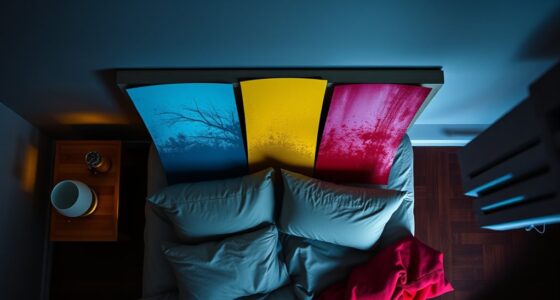Cool colors like blue, green, and purple create calming environments that help you relax and feel more balanced. Blue is linked to trust and serenity, green promotes growth and stability, while purple encourages inner peace and tranquility. Using these hues in your space or wardrobe can reduce stress and boost emotional well-being. To discover how you can incorporate these soothing shades effectively, explore more about their psychological and cultural impacts.
Key Takeaways
- Cool colors like blue, green, and purple promote relaxation, focus, and emotional balance in various environments.
- These hues are culturally associated with tranquility, trust, vitality, and spirituality, influencing subconscious responses.
- Incorporating cool colors in spaces such as bedrooms or meditation areas enhances calmness and reduces stress.
- Wearing or decorating with these colors can boost confidence, promote peace, and support mental well-being.
- Understanding color psychology enables deliberate design choices that foster harmony and emotional stability.

Have you ever wondered why shades of blue, green, and purple evoke a sense of calm and tranquility? These cool colors have a unique ability to influence your mood and perception, rooted in both psychological impacts and cultural associations. When you surround yourself with these hues, you’re often creating an environment that promotes relaxation, focus, and emotional balance. The psychological impacts of these colors are well-documented; blue, for example, is linked to feelings of serenity and trust. It’s no coincidence that many bedrooms and spas favor shades of blue, aiming to reduce stress and encourage restful sleep. Green, often associated with nature, symbolizes growth, renewal, and harmony, which can help ease anxiety and foster a sense of stability. Purple, especially in its softer shades like lavender, is connected to spirituality and inner peace, making it a popular choice for meditation spaces or calming decor. Additionally, color psychology plays a significant role in understanding how these hues can positively influence mental health and well-being.
Your cultural associations with these colors also play a crucial role in their calming effects. In many Western societies, blue is tied to calmness and professionalism, which is why it’s frequently used in corporate branding to evoke trust and reliability. Green is linked to health and vitality, reinforcing its soothing qualities and its connection to natural environments. Purple, historically associated with royalty and luxury, now often signifies wisdom and tranquility, adding a layer of elegance and serenity to any space. These cultural meanings reinforce the psychological impacts, shaping how you interpret and respond to these colors on a subconscious level.
When you incorporate cool colors into your environment, you’re tapping into these deep-seated associations and psychological responses. For instance, painting your living room in shades of green or blue can help create a peaceful sanctuary away from the chaos of daily life. Wearing purple might boost your sense of calm and confidence, especially during stressful moments. The way these colors are perceived varies across cultures, but their calming effects tend to be considerable, making them an effective choice for spaces meant to relax or focus.
Ultimately, understanding the psychological impacts and cultural associations of cool colors allows you to harness their calming power intentionally. Whether you’re choosing paint, decorations, or clothing, these hues can considerably influence your mood and environment. By deliberately incorporating shades of blue, green, and purple, you’re not just decorating—you’re creating a space that nurtures peace, balance, and well-being.
Frequently Asked Questions
How Do Cool Colors Influence Mood and Mental Health?
You’ll find that cool colors promote emotional stability and help reduce stress. When you surround yourself with blues, greens, and purples, they create a calming atmosphere that eases tension and promotes mental clarity. These hues can help regulate your mood, making you feel more relaxed and centered. Incorporating cool colors into your environment can be a simple yet effective way to improve your overall mental health and emotional well-being.
Can Cool Colors Improve Productivity in Workspaces?
Yes, cool colors can improve productivity in workspaces by leveraging color psychology. Incorporate blues, greens, and purples into your workspace design to create a calming environment that reduces stress and enhances focus. These colors help you stay relaxed yet alert, making it easier to concentrate on tasks. When designing your workspace, choose cool tones strategically to foster a productive atmosphere and boost your overall efficiency.
What Cultural Meanings Are Associated With Cool Colors Worldwide?
You might notice that cool colors often symbolize tranquility and trust in many cultures, but their meanings can vary globally. For example, blue represents peace in Western countries, while in some Middle Eastern cultures, it’s linked to protection. Green can signify fertility or prosperity worldwide, yet in Asia, purple might symbolize spirituality or nobility. Understanding these cultural symbols helps you appreciate the diverse global perceptions of cool colors.
How Do Cool Colors Affect Sleep Quality and Relaxation?
Cool colors in your sleep environment can enhance relaxation and improve sleep quality through color therapy. By incorporating blues, greens, or purples into your bedroom, you create a calming atmosphere that signals your brain to unwind. These hues help lower stress levels and promote restful sleep, making it easier for you to fall asleep and stay asleep longer. Embrace cool colors to foster a peaceful, restorative sleep environment.
Are Cool Colors Suitable for All Interior Design Styles?
They say, “Beauty is in the eye of the beholder,” and yes, cool colors suit many interior styles. You can combine blues, greens, and purples with warm accents for a balanced look, making them versatile across modern, traditional, or eclectic designs. Color combinations matter, so choose shades that reflect your style. Cool colors create calm, but blending them with warm tones keeps your space inviting and stylish.
Conclusion
So, next time you need a moment of peace, surround yourself with blues, greens, and purples. These cool colors are like gentle whispers from nature, soothing your mind and calming your soul. They’re the quiet lullabies that ease your worries and refresh your spirit. Embrace their tranquil embrace, and let their serenity wash over you like a cool breeze on a warm day. With these colors, calmness is just a glance away.








